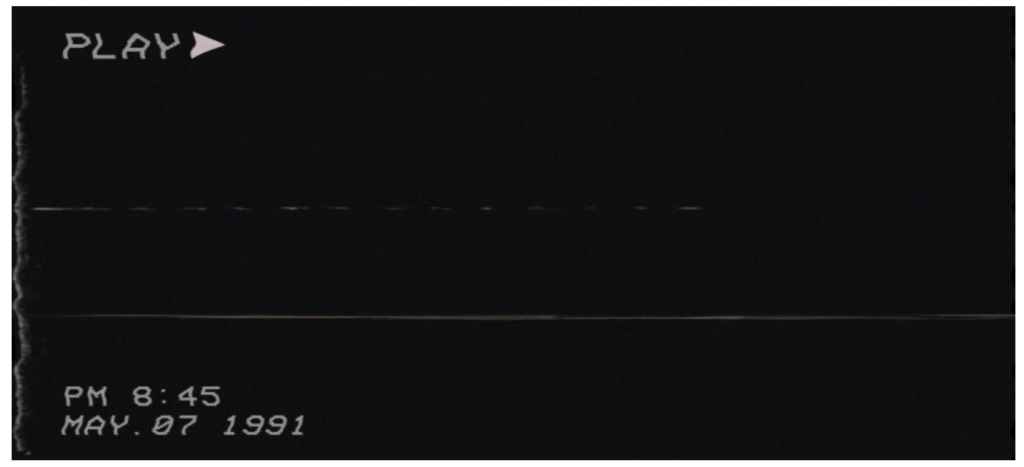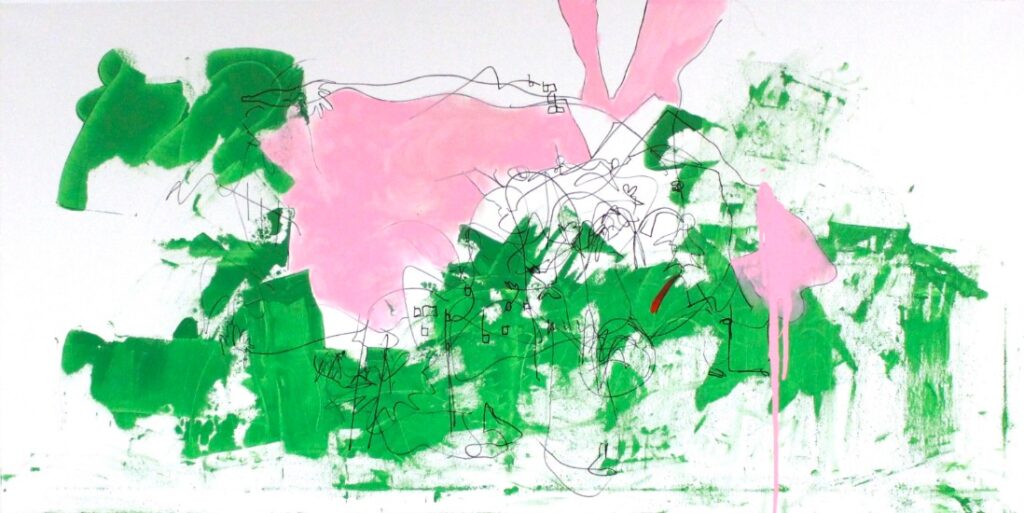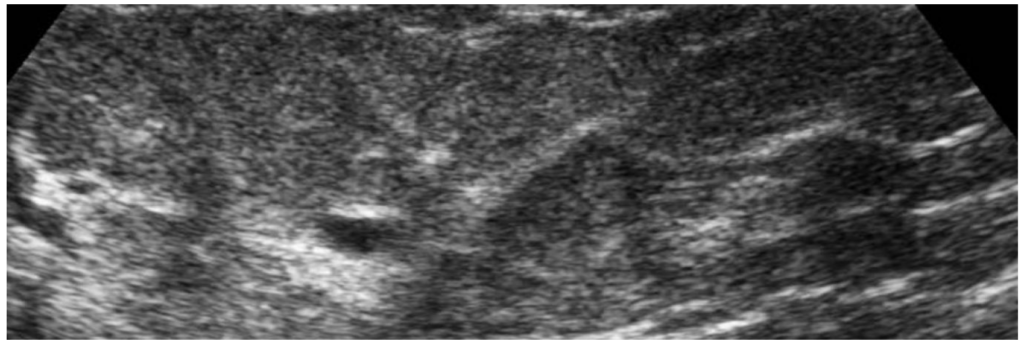Keaton Fox
Our guest author Keaton Fox is an artist whose works reflect and distort the varied realities of our time, and invite viewers to collectively question the aesthetics shaping the fever dream that is 21st century life.
Niio Art recently launched a solo show artcast of some of Keaton Fox’s “Motion Study” series artworks titled Morphing Memories.
In this text, “Origin Story”, Keaton Fox shares part of her thesis work with us “Aesthetics for Forgetting”, which will be available for purchase later this year.
Keaton Fox, Motion Study from Merino Park, 2022.
Your father recorded your birth on a Hi8 video tape in 1992. You were shown the video of your birth when you were five years old, and have been obsessed with this Hi8 video tape ever since.

AT FIRST
At first, it served as a time-traveling tool. The surrealness of seeing the beginning of one’s emergence into the world unlocked something pivotal within.
It manifested a yearning and a longing and a searching for something...not yet known.
At first, this desire was linked with the traditional sense of nostalgia that
media representation seemed to offer. The ability to see a moment one could not recall provided all the things that excite the senses. It was eerie, it was exhilarating, and it was malleable.
Being able to fast forward and rewind time gave you, as it gives all humans, an illusory power that tends to shift from wonder to play to control, and you couldn’t get enough of this newfound potential. This portal to the past was enticing, and you only fell deeper into its time-based trap.
At first, it was endearing, as most home videos tend to be. Rarely showing the hardships, these moving images offered pixels of warmth through birthday candles, holiday lights, and other luminous cliches of familial togetherness.
But the more you watched, the more you uncovered.

THE SHIFT
The tapes shifted from forgotten moments to remembered ones, and with this shift in content came a shift in tone. A dissonance grew, as the tapes exhibited moments that opposed the memories in your mind. Childhood moments you clung onto as an adult - moments that shaped your internal monologue and outward identity - were being played back in ways that forced you to read your - what you began to call ‘organic memories’ - as less than true. Most significantly, your first memory in which you were proud of yourself - a moment you would revisit often in adulthood in moments of weakness - was proven otherwise. It was your fifth birthday party. It was ballerina themed. Your mother’s friend, who was a dancer, was teaching you and all your friends how to leap in the air. The final test was to jump over a small creek. You were five years old. You were nervous. You were afraid to fall into the water, on this special day, in front of everyone you knew. But you leapt over the creek and stuck the landing. It was the first risk you ever took and it was the first time you learned to trust yourself, your body, and your mind. When you re-watched your fifth birthday through the home video recordings, there was only solid, green, Floridian grass. No water. No creek in sight. This meant there was no risk. Which meant there was no trust. While this may seem like a small moment, it was the snowflake that led to an avalanche. Once that trust was disproved, your reality was permanently altered. What happens when the moments you cherished most are proven false by a piece of technology? What power lies in the confines of these pixels? What are the perceptual effects of a ruptured reality? What kind of control lies in the person behind the camera? What kind of power lies in the makers of these machines? Years were spent attempting to answer these questions. Within the same years, your mother’s mother developed dementia. You both bonded over this unnatural connection of forgetting that was plaguing you both, separately but simultaneously. You, having been convinced that your earliest memories were untrue. Her, experiencing the slippage of the mind that was once a source of stability. This loss of trust, in medium and in self, created a bond. Particularly because Alzheimer’s has made itself present in nearly every generation on your mother’s side. This loss continued to grow and shapeshift as the years continued. The disillusionment of memory depletion morphed into a continual sense of doubt, making you both easy targets for manipulation and abuse. Because if you cannot trust your own mind, your own memories, and your own reality - your sense of self begins to crumble. This is why abusers continually start here, making the victim doubt their notion of what has or hasn’t happened. A staple in the gaslighting how-to’s. But you weren’t dealing with a human in this instance. And neither was she.

THE RETURN
In an attempt to disrupt the disintegration, you returned to the tapes you used to adore and now resented. This return was an act of revenge, aimed at hacking a sense of reliability within this pivotal glitch in your internal matrix. It all, inevitably, came back to the birth tape. The beginning of the end had to be returned to once more. And it is in this ubiquitous moment of emergence that Trying to Remember Being Born was birthed. This tape offered insight to not only your birth but to every birth. In a present defined by divides, this tape offered a universal connection. Because every person has experienced their own birth. More significantly, however, every person has forgotten this equally monumental and horrific beginning. That was, at least, how it seemed to be. At first.
THE SEARCH
The attempt to remember the forgettable began with research. Searching for the
answers to this romanticized form of infantile amnesia proved fruitful.
There was endless knowledge and horrors found throughout the centuries - from
familial interviews to ancient mythologies to Youtube folklore and beyond.
While the information was abundant, it was never circular. The stories and the
data and the histories all branched off from the central theme at hand. Within
this realization, the theme of the quest shifted.

THE REALIZATION
Trying to remember being born was never the true mission of the work. This experiment was aimed at discovering the outcome of wholeheartedly pursuing an entirely outlandish hypothesis. You wanted to see what would happen if you indulged in this narcissistic and unstable landscape of the mind. You wanted to use art as a means to find clarity within the utter chaos of surviving in the 21st century, particularly in the thick of the entirely outlandish time period that was the year of 2020. These were some of the goals. What was found, instead, was something far more shocking. And, ultimately, more inspiring. As the COVID-19 pandemic drug on, this project, and graduate school in general, functioned as a welcome distraction. Knowing that your grandmother lived alone during this time, you invited her (virtually) into your experimental escapades. You called her often - to check up on her mental and physical health and to keep her entertained with stories divorced from the nightmare that was lurking outside. Your references would often make her laugh, and the fact that you could entertain your immuno-compromised elder with your ridiculousness was what made the entire project worthwhile. It’s been two years of back and forth, and her dementia has progressed, audibly so. She is aware of what is happening, which makes it all the more heartbreaking. You’ve shared the uncanniest moments in which she attempts to articulate her frustration - but can’t find the words to do so. And in these moments, she questions why you would ever try to remember being born.

In these moments, you pull out the most potent research that this entire process has offered: the tales of forgetting as a form of blessing. The stories in which the ability to forget is regarded as a superpower and a necessary good against the wickedness in the world. Mythologies surrounding the Broth of Oblivion and the failure of the archive and how the Tree of Memory sets its roots in blood. Alternatively, you also tell her about the histories in which humans have gone great lengths to return to something that has been forgotten - only to end in total tragedy and devastation. Histories like the death of Candace Newmaker, the child who was accidentally suffocated to death by her own therapist and care-takers during a session of rebirth therapy - a therapy in which humans attempt to return to the warmth and the metaphor of the womb. She still swears that forgetting is the worst curse imaginable, but you argue against this notion. Not because you believe it to be true, but because you hope for it to be. Because you need it to be. Because you can see yourself in her state and you can see unassuming others in the state you are in now. You know the curse of this degenerative disease is coming for you. You know the curse of video is coming for us all. Even those that have yet to be born.
AT LAST
The systems that exist to disrupt our sense-making abilities... whether external, through convincingly realistic representation technologies like video... or internal, through the invisible yet relentless diseases that take shape within our own skin... ...these systems are ever-present and always lurking, and are few examples of many. But if we can reveal these perceptual catalysts, through art or otherwise, then we can reach the epiphanies on the other side of the unknown.

THE MOTION STUDIES The Motion Studies are a continuation of this journey onto the other side of the unknown. In their simplest form, these video artworks visualize the distorted space between fact and fiction. By morphing video documentation into moving image abstractions, the studies create distortions that mirror the invisible feeling of unending distrust that has come to define 21st century life. They are the most recent works from the artist, offering a visual representation of the distortion described in the above text.
Keaton Fox, Motion Study from the Dawndridge, 2023.
